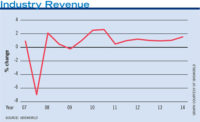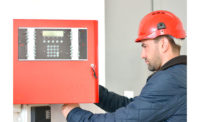On April 27, 1967, Dante Monteverde founded what is now EMERgency24 in Chicago. EMERgency24 was a pioneer of the third-party central station business model and today has about 100 employees, four locations and hundreds of thousands of subscribers. From the beginning, Monteverde had a passion for creating and developing, and he knew that the future of security was going to be with technology and the digital/computer age.
It’s this passion that is the backbone of the story. Staying true to the original vision, EMERgency24 has come out with a stream of in-house developed, technological advancements over the past 50 years. Perhaps one of the most significant developments for the monitoring business was the software Monteverde wrote in 1976 that took the manual process of an operator receiving an alarm signal, looking up the customer and cross-referencing their data in a Rolodex, digital. The software allowed the central station to automatically identify the number that a signal was coming from.
In the late 1980s, EMERgency24 engineers developed the company’s first completely interactive software program called the Chicago Connection, which allowed dealers to see full subscriber account information and history on their personal computers. (Though the internet itself has been around since the mid-’60s, its recognizable form to most of us — the World Wide Web — wasn’t invented until 1990.) In the late 1990s EMERgency24 developers came up with a way to tie video streams directly to the alarm signal for dispatchers, giving them more information about an event than ever before. With the birth of the iot age, EMERgency24 brought dealer and subscriber phone apps, PERs service and, its most recent offering launched in 2015, Incident Command and Communication Services for two-way mass notification, which includes an interactive floor plan showing the location of an incident and any accessible video cameras available for live streaming.
But of course, that’s not where this story begins. It begins with a young man who immigrated to the United States from Chile as a teenager. Monteverde was drafted into the U.S. Army and stationed in Korea, where he threw himself into learning as much about electronics as possible during his tenure and was honorably discharged as a sergeant.
Back in Chicago, Monteverde took a software writing development course — one of the first of its kind available to citizens. And perhaps that is where the initial seed was planted for what would become one of the largest third-party monitoring companies in the U.S. Somewhere after a time working at Chicago Fire and Burglar — an alarm company still in existence today — Monteverde decided to go out on his own, opening Alarmtronics Inc. in Chicago, installing and monitoring his own alarm accounts. He had a small storefront on 1824 Elston Ave., Chicago. It was that first year that he applied for a U.S. patent covering the telephone dialer apparatus (tape dialer), which he sold out of the storefront. An add-on to an alarm system, the tape dialer was pre-programmed to dial a number with a pre-recorded message of the alarm event when an alarm was activated.
EMERgency24’s 50 year at a Glace
April 27, 1967 - Dante Monteverde founds Alarmtronics Inc. in Chicago
1967 - Monteverde applies for U.S. patent covering tape dialer
1971 - Changes named to Emergency Data Computer Center Inc. and established third-party monitoring business model
1976 - Central station gets computerized (automates the alarm event and subscriber info)
1977 - Hires first full-time employee, Stara Ference, and changes name to Emergency Twenty Four Inc.
1980 - Brings full redundancy to the central station
1982 - Launches LifeCard service, which records subscriber info, such as medical records, to provide authorities in the event of an accident
1984 - Receives UL certification
1985 - Launches service which notifies dealer of alarm events from all active accounts via fax and/or email
1986 - Opens Washington D.C. office and establishes second fully automated branch
1987 - Opens San Francisco central station and launches interactive software program called Chicago Connection, delivering full subscriber account data and history to dealers’ computers
1997 - Dealers able to bring new subscribers online using company’s Dealer Internet portal
1998 - Opens Los Angeles branch as a backup location and launches ValidatedSite for third-party validation of websites and InternetSupervision as a service to monitor performance and content of websites
2011 - Opens Waukesha, Wis., branch as a backup location
2013 - Unveils dealer and subscriber phone apps and launches EM24 Alert, personal emergency response service
2015 - Develops Incident Command and Communication Services for two-way, mass notification
“My dad had ambitions. He thinks big,” says Dante Monteverde Jr., now a co-owner of the company, along with his siblings. “It was a struggle, though, in the beginning. It was not easy and there were definitely tough times making ends meet. I don’t know if he thought the company would have been around for 50 years back then, but he certainly had a vision.”
Four years after the beginning, Monteverde realized that the most time-consuming part about the alarm business was the monitoring process. With his background in electronics and software development, he could see even then that there was a need in the marketplace for a computerized, dedicated monitoring model. And so, in 1971, Monteverde changed the name of his business to Emergency Data Computer Center Inc. and began approaching alarm businesses in Chicago with an unheard of proposition — he would not compete against them to install systems or sell hardware; he would monitor their accounts for them and take that off their to-do lists so they could focus on the sales.
“He was always fantastic at marketing,” says Baird Larson, vice president and director of technology, who started working for EMERgency24 in 1986. “He’s always focused on what is the benefit to the customer, putting himself in their shoes.”
Dante and his wife Alicia would spend many nights sleeping at the office in those early days, doing the alarm monitoring. The business started to grow, almost to 50 accounts in the Chicagoland area by the mid-’70s. All in 1977, the company moved offices again, changed its name to EMERgency24, and hired its very first employee, Stara Ference, to handle overnight monitoring. The job was supposed to be a temporary one for Ference, who lived in the neighborhood at the time. Sometimes, her young son would spend time at the central station. That son, David Howard is now a collections manager at the company going on more than 20 years and Ference is now EMERgency24’s first-shift operations manager — having lived through four office moves in her time.
As soon as toll-free numbers were in service at the beginning of the 1980s, EMERgency24 took its business nationwide. Monteverde frequented tradeshows to spread the word about his business model and its services, and he advertised, at first locally in yellow pages, and later nationally in trade magazines. His knack for marketing showed through, just as much as his love for technology and innovation.
“Dante realized he had to touch as many people as possible to grow. He saw a need in the market for companies being able to focus on selling while someone else monitored their accounts,” recalls Kevin Lehan, Wisconsin branch manager and manager of public relations.
In 1980, the company brought full redundancy to the industry by initiating a second independent computer, allowing the company to do immediate backup of the company’s data. A few years later EMERgency24 began offering its LifeCard service, which allowed the company to keep track of subscriber information digitally, such as medical records, and to provide this to authorities in the event of an incident. Other milestones in the 1980s included opening its fully automated Washington D.C. branch that was linked together with its Illinois central station, as well as going through the rigorous UL certification process for its central station.
Today, EMERgency24 continues its tradition of all in-house software and development. “We are at the same place we were 50 years ago when Dante was trying to make his dealers more competitive in the marketplace,” says a semi-retired Patrick Devereaux, consultant and past senior vice president at the company, who led the monitoring centers for more than 25 years. “That’s exactly what we are doing today and will do into the future.”








